I want to add a colored point (red or green) on every "crossing" between the rings and segment lines. Is there a simpler way than making 240 Series which just have two datapoints?
-
In all cases where I have used Polar graphs like the one you have above the velocity or rate of change was important. So I find it interesting that you want to put a single dot on the 1 hour boundaries. It is possible that you are putting an average of the previous hour on a dot on the line, so then I get that case. In your situation I would manipulate the final data to the polar graph render code. The Modified data would just have one data point for each hour – 24 data points per day on the hour ( 15 degree interval). I would experiment in Excel first. – Sql Surfer Aug 21 '16 at 14:37
-
I have a dictionary that has a boolean value for each point and I basically want to show if it is true or false. There is no rate of change after all the data is in the dictionary it is drawn. – Mr_Grennn7 Aug 21 '16 at 14:40
1 Answers
1 - There is no need to create different Series. Just add the DataPoints you want at the spots you want! This is the easiest way, since you already know the values.
2 - As an alternative you can use a xxxPaint event and draw filled circles (or whatever you fancy..). For this you need to convert the values to pixels. This can usually be achieved with the AxisX/AxisY.ValueToPixelPosition methods. However for Polar Charts this will not work. Instead you need to calculate the pixel coordinates yourself..
The 2nd way is a bit harder, but of course will give you more control over the style of the points you draw..
Here is the result of adding DataPoints:
Example code for the 1st version; first we set up a polar chart with its axis properties:
Chart chart = chart2;
chart.Series.Clear();
ChartArea ca = chart.ChartAreas[0];
Axis ax = ca.AxisX;
Axis ay = ca.AxisY;
ax.Minimum = 0;
ax.Maximum = 360;
ax.Interval = 15; // 15° interval
ax.Crossing = 0; // start the segments at the top!
ay.Minimum = 0;
ay.Maximum = 10;
ay.Interval = 1;
Series s0 = chart.Series.Add("points");
s0.MarkerStyle = MarkerStyle.Circle;
s0.SetCustomProperty("PolarDrawingStyle", "Marker");
s0.MarkerSize = 6;
s0.MarkerColor = Color.Teal;
s0.ChartType = SeriesChartType.Polar;
And then we add the points at the crossings and finally style one of them to show that they all can be different..:
for (double vx = ax.Minimum; vx < ax.Maximum; vx += ax.Interval)
for (double vy = ay.Minimum; vy <= ay.Maximum; vy += ay.Interval)
s0.Points.AddXY(vx, vy);
s0.Points[333].MarkerColor = Color.Red;
s0.Points[333].MarkerSize = 12;
For the code to calculate the pixel coordinates see this post!
Using the function in the link and this PrePaint event:
private void chart2_PrePaint(object sender, ChartPaintEventArgs e)
{
Chart chart = chart2;
ChartArea ca = chart.ChartAreas[0];
Series s0 = chart.Series["points"];
foreach (DataPoint dp in s0.Points)
{
PointF pt = PolarValueToPixelPosition(dp, chart, ca);
e.ChartGraphics.Graphics.DrawEllipse(Pens.OrangeRed, pt.X - 5, pt.Y - 5, 9, 9);
}
}
we can adorn each point with a circle:
Or course, if you don't want to add the DataPoints in the first place, you can replace them by calculating the values like I did in the loops that added them..
-
-
I implimeted it but I have a new question related to it http://stackoverflow.com/questions/39828410/changing-a-c-sharp-graph-from-polar-do-radar please help me. Thank you. – Mr_Grennn7 Oct 03 '16 at 09:34


